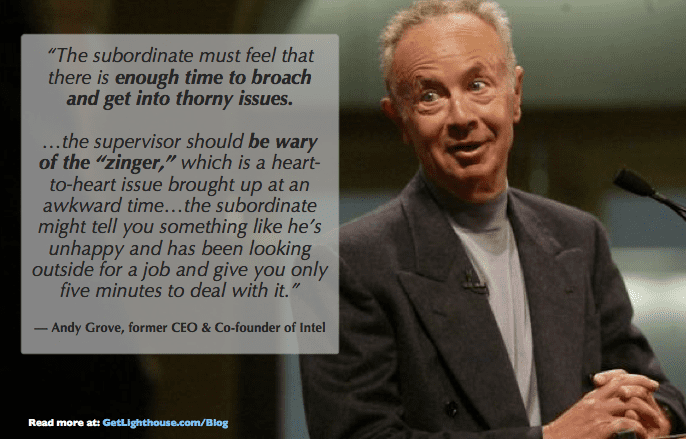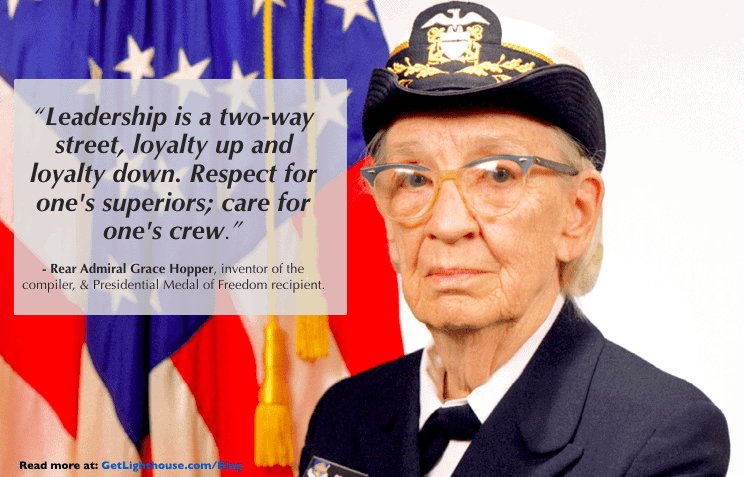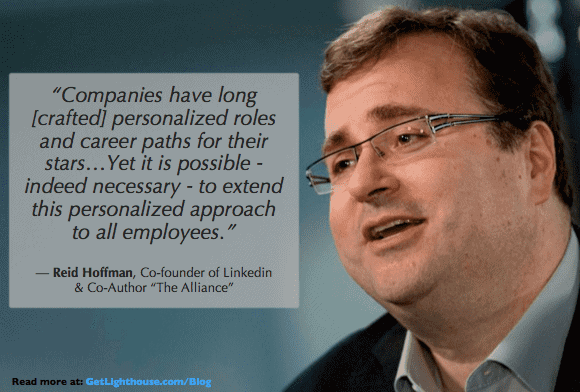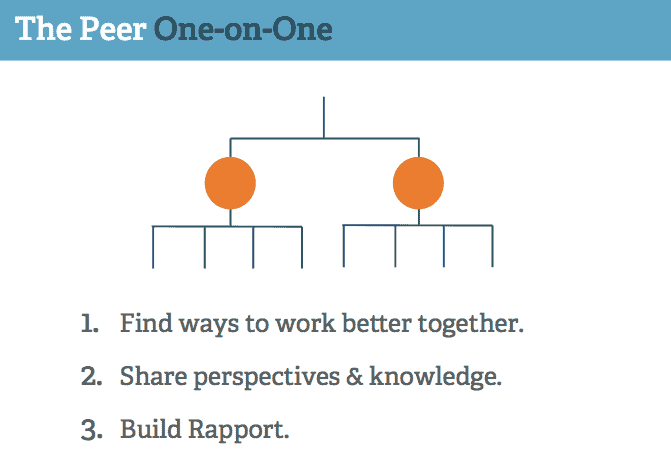Do you often forget to set aside time to meet with your team? Or do you feel like you're meeting with them too often and things are getting repetitive?
As a manager, your one on ones are your most powerful tool. They're the building blocks of all your relationships and the best way to motivate your team (and yourself) to stay consistent in your work.
But is there such a thing as too many or too few one on ones? How can you tell what the best meeting cadence is for discussing specific topics with your team?
In today's post, we'll discuss four types of check-in most managers have with their teams, what the best meeting cadence for them is, and point to resources for learning more about them.
The Best Meeting Cadence for 4 Different Types of One on Ones
While the pool of topics you can discuss with your team is practically endless, we've grouped one on ones based on 4 key areas we've found to play a key role for team morale, retention, and building rapport.
They are:
- General one on ones with your direct reports
- Skip level meetings
- One on ones that focus on career growth
- Peer one on ones
Let's discuss the specifics of each of these four types of meetings and how often we recommend you have them.

General 1 on 1s with your team
You can think of your 1:1s as a Swiss Army knife. They're intended for a variety of situations and meant to be used often. Just like the knife has a can opener, magnifying glass, scissors, and a variety of other hidden tools, so do your 1:1s. Using 1 on 1s well will help you:
- Uncover how your team is truly feeling
- Help you detect and address problems on time
- Give detailed, effective feedback and coaching
- Build rapport with your team
- Find time to discuss your team member's career growth (which we'll discuss in more detail)
The list doesn't end there. The more you have 1:1s, the more you'll start to understand their hidden value and unlock it.
It's why many successful leaders such as David Cancel, Ben Horowitz, Kate Matsudaira keep mentioning them as their go-to method for solving problems and ensuring their teams are happy.

What is the best meeting cadence for regular one on ones?
"A journey of a thousand miles begins with a single step".
- Chinese proverb
One on ones are the building blocks of everything you do as a manager. If you're consistent with having them, and making good use of the time, you'll start to see small but incremental changes in everything your team does. From the quality of their work to their attitude, they can all be improved if you use your 1 on 1 meetings well. Over time, these changes will add up to make a massive difference.
For this to happen, schedule weekly or bi-weekly meetings that last 60 minutes.
The best meeting cadence for small teams (up to five people) is every week, whereas you can meet every other week in case you're leading larger teams, or know your people extremely well.
Is meeting for an hour really necessary?
Absolutely. A weekly meeting cadence and 60 minutes will give you plenty of time to make real progress on what you discuss. As Intel founder Andy Grove puts it:
"I feel that a one-on-one should last an hour at minimum. Anything less, in my experience, tends to make the subordinate confine himself to simple things that can be handled quickly.”
Besides, investing one hour in each of your team members is a small investment to make for the value you get out of them. You can always end early and you both get a little time back. Meanwhile, you won't achieve any progress if you're late to a 30-minute meeting that now is just a quick 15-minute check-in, especially when you're facing with a "zinger.”

As Andy Grove explains, without a dedicated time to talk to your team, they may bring up important issues when you're least prepared for them.
To stay consistent, book your one on ones as recurring events on your calendar so you don't forget them or accidentally schedule something over them. Make sure it's a time you can stick to; there's nothing worse than constant rescheduling, or worst of all, canceling your one on ones.
Creating a meeting cadence you and your team can maintain is vital to the health of the one on one and the relationship with your team member.
Here are some resources on how to make the most of them:
- Helpful One-on-One Meeting Template for Managers
- One-on #-One Meeting Questions Great Managers Ask Their Teams
- 25 Reasons You Must Start Having One on Ones with Employees

Skip level meetings
How are your managers really doing? What's really happening in your organization? What do your people really think?
If you're a senior leader, these questions are likely to be on your mind at least once in a while.
Being more removed from day-to-day work is an inevitability of climbing through the ranks as a manager. However, that doesn't mean you're walled off from ever finding out how your team members are feeling and what they think.
Skip level meetings are one of the best ways to gather the information you couldn't get any other way.

But what are skip level meetings exactly?
Skip level meetings are check ins between you and the direct reports of the managers under you.
They allow you to gather valuable micro- and macro-level feedback that helps you build a healthier and more productive work environment. In doing so, they let you bridge the gap between you and your employees.

What is the best meeting cadence for skip level one on ones?
If you've recently started managing other managers, you likely won't have many direct reports. However, as your career starts progressing, you may end up with dozens of them, making it harder to find time to meet with everyone..
We recommend being careful how many, and how often you have these meetings.
Specifically, meet with the reports of the managers you lead no more than once a month. Then, as your team grows, the best meeting cadence is to meet with each skip level team member once every 3-6 months. If you put the meetings to good use, you don't need to have them very often to get a lot of value from them.
Skip level meetings are a great tool, but the primary line of communication should be Individual Contributor (IC) -> Manager -> You. If you forgo that middle step, you're putting the relationship your managers have with their team at risk.
Your main goal is to keep a pulse on how things are going, but also ensure you're not interfering with other people's work or micromanaging them.
A key question you can ask to accomplish this is: "Have you talked to your manager about this?” This reinforces and encourages open communication between the ICs and their manager.
If you set the right expectations for your team and not go overboard with skip level meetings, you'll be well on your way to making the most out of them. You'll learn key insights your team wants you to know as well as areas to improve (or praise!) your managers.
New to Skip Level 1 on 1s? Here's a great post with more in depth detail on how you can become great at them:
- Skip Level Meetings: Everything you need to know about Skip Level 1 on 1s
- Awesome skip level meeting questions for managers to ask
- Questions for senior leaders

1:1s focused on your team's career goals
Want to know the secret of retaining your best team members for years to come?
While many things can temporarily motivate people, the one thing that keeps employees around the world more motivated than a bigger paycheck or any other workplace benefit you can think of is - career growth.
According to Linkedin's 2018 Workplace Learning Report, a staggering 94% of employees would stay with a company longer if they invested in their career development.
However, a study by global staffing firm Randstad found that only 49 percent of employees believe their leadership team is creating enough growth opportunities for them.
Conversations about career growth often seem to be put on the back burner. There's always something more pressing to talk about or address.
Before you know it, it's the end of the year and you haven't really discussed your team members' career goals or helped them achieve them. Too often, this can result in them becoming frustrated and deciding to leave.
To prevent that from happening, make career growth a part of your discussions with your team regularly.

What is the best meeting cadence for 1:1s that focus on career goals?
Your best workers want to grow. It's important to them and they'll always be pushing for it. Meanwhile, even the average worker wants to advance and get raises and the occasional promotion.
In order to achieve that growth for everyone, you have to find the right balance of regularly talking about it, and actually leaving enough time for them to have made progress on their growth. ,That's why we recommend you aim to discuss their growth every 4-5 check ins.
Monthly makes the difference
To make career goals turn into real progress, you have to do more than simply talk about a high level goal like a promotion. You also have to help them build the skills, knowledge, and experience to get there.
You can do this by helping them figure out concrete next steps they should take to accomplish their goals. Then, to make sure the progress happens, and help them improve, you need to follow up on them regularly.
In those meetings where you talk about their goals, look for opportunities to coach them, or think about people you can introduce them to that could help.
Even more importantly, try to get them to act on what you discuss. One of the best ways to do that is to use the SMART model. This means making their goals:
- Specific – target a specific area they can improve in.
- Measurable – look for a way to quantify or measure their progress.
- Assignable – specify who is responsible for what step. For example, they can be responsible for completing a course, whereas you can be responsible for finding them a mentor and making an introduction.
- Realistic – be reasonable in your expectations and set goal steps that are of an achievable size. Small, regular progress is better than giant, daunting ones.
- Time-related – specify a deadline for them to achieve their goals. Then check against that deadline to ensure they're making progress.
Be flexible and adapt
Another thing to remember about career goals is that they're not set in stone. They can evolve over time, which is why it's so important to address them consistently.
These changes can be everything from small changes to steps they'll take based on how you see them progressing, to bigger ones where they realize they want a different role than their original goals.
The key is for you to check in on how your team feels about their career development regularly so you can make progress and changes together. You can do this by asking questions like:
- Is X still your career goal?
- What tweaks do we need to take to stay on the right path?
- Are you making progress on the steps we agreed to? What's blocking you from growing?
By asking these questions and similar ones, along with the right meeting cadence for addressing their growth, you'll show your team members you genuinely care about them and keep them happy and motivated for years to come.
Need to tune up how you help your team members grow? Here are our best resources on having great career conversations and helping them make real progress on them:
- How to Help Your Team Achieve Their Goals
- Employee Development: How to grow your employees when you can't promote them
- How to Find a Mentor for Your Team Member

Peer 1 on 1s
Many managers are so busy, they can't find time to build a meaningful connection with their colleagues. They often maintain surface-level relationships that boil down to the bare minimum both sides need to do their work. Or even worse, the relationships are actively strained, but with nothing done about them.
To fix this, and not only mend any damage, but create great working relationships, the best managers have peer 1 on 1s regularly.
If you set aside a bit of your time to meet with a peer every once in a while, you will
1) Build more cohesive, collaborative cross-functional teams.
2) Fix inter-team problems and frustrations.
3) Uncover ideas to work better together
4) Strengthen bonds with your peers and make everyone's work more enjoyable.
Yet, you only get those benefits if you make the most of peer 1 on 1s. These meetings are only as valuable as the effort you put into preparing, and then following through, on what you discuss.
What is the best meeting cadence for peer 1 on 1s?
The truth is, this will vary a lot. A good rule of thumb is to think about the relationship with your peer:
- How often do you work with them? The more you and your team does, the more you should have peer 1 on 1s.
- How many problems or issues do either of you have right now? If there's a lot of friction, frustration, or problems, open up those communication lines by meeting more.
- How well do you know them? If they're new to the company or working with you, meet more often to build a strong, collaborative foundation.
- Do you always have more to talk about than time? If you're running over time every time you meet, it's probably time to meet a bit more often.
There's no definitive answer here, but most peer one on ones we've seen occur every 4 to 12 weeks based on the rules above.
If you're new to peer 1 on 1s, they're something you should definitely consider. If you want to learn more, you can read an in depth post we've written about them, including great tips on how to turn them into one of your most useful tools:

What every meeting needs: A Clear Purpose + Agenda.
"You should never go to a meeting without a clear idea of what you are trying to achieve.”
- Steve Jobs
Even after deciding on a meeting cadence, many managers will struggle with facilitating one on ones of any kind. That's because they don't make good use of the time.
Without proper planning, both you and your team member could start thinking "Why are we even having this meeting?”
To ensure that doesn't happen, spend a bit of time ahead of the meeting on creating an agenda (and ask your team member or peer to contribute as well).
Meeting agendas can really level up your one on ones; they ensure you cover the right topics, and get the other person thinking ahead about the meeting, too. They also let your team know what the meetings are for, which can make it easier for them to contribute good topics as well.
With just a bit of preparation and structure, you can get the most out of the time you invest in each meeting.
And if you struggle with making an agenda or things start to feel repetitive, then you may want to adjust the frequency of your meetings. Or, you may simply need to learn more about how to make the most of these meetings.
A few new topics or great questions can open up new insights and reinvigorate stale, repetitive meetings.
We've written more about how you can create great agendas and improve your meetings in these posts:
- Why Your One on One Needs a Meeting Agenda (and How to Make Them Great)
- How to Have Great Meetings: 10 Tips for Conducting Effective Meetings
- Could this meeting have been an email? Recommendations on when to use asynch communication
- One on One Meetings Template For Managers To Use
We know how valuable one on one meetings are, because we've spent over 7 years perfecting them for thousands of managers like you. We've made it our mission to help managers get the most out of the time they spend with their team in a variety of situations.
You can learn how Lighthouse Lessons can help your leaders like we helped SeedBox Technologies by signing up here.





